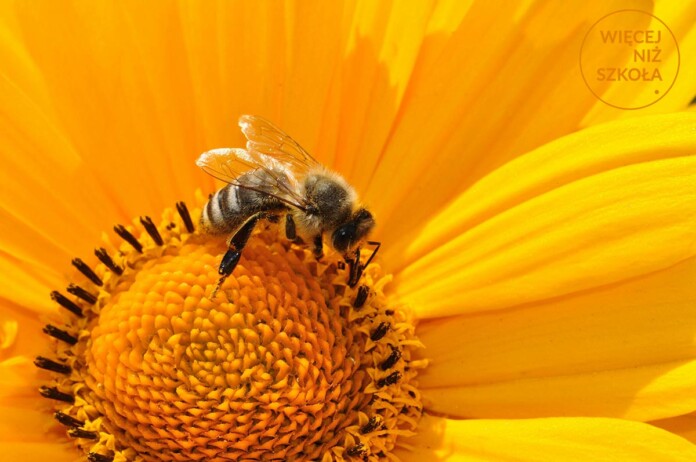Wiosna nie rozpieszcza nas zbytnim ciepłem, szczególnie o wczesnych godzinach porannych, kiedy zmierzamy do szkoły doświadczani temperaturami ledwie powyżej zera. Cierpliwości! Już niedługo zagości piękna pogoda, zakwitną bukiety kwiatów, wokół których zaroją się owady. Na przykład pszczoły. A przy okazji… zapraszamy do przeczytania świetnego artykułu Hani Pająk (z klasy 2b) o pszczołach właśnie i o ich fascynującym życiu!
=================
The interesting life of bees
Bees are among the most collaborative insects in the world. Each hive is made up of thousands of bees who work together to build and maintain a colony. Each bee plays a specific role in the colony. This involves tasks such as finding food, caring for the larvae, and building the honeycomb.
But since the brain is about the size of a sesame seed, the question arises: how do bees know what specific tasks they need to perform to maintain balance in the hive? The answer is written into the genetic makeup of each bee, starting with the queen bee, which has the unique ability to determine the sex of her child, which plays a vital role in their future.
In her first week of life, the queen mates with up to 20 drones or male bees, filling the spermatheca behind her ovaries with spermatozoa but without releasing any herself. This process fertilizes a female egg. If the queen wants to lay a male egg, she will not release any spermatozoa as the egg leaves the ovaries.
Drones have a singular job. To spread the species, it is their responsibility to mate with queens from the neighboring colonies. They wait for the queen to take her nuptial flight and feed leisurely from the honey reserves when they aren’t attempting to mate.
Worker bees, or female bees, perform all other tasks. They clean the cells, tend to the larvae, construct new cells, look after the queen, store honey, forage, pollinate, and even provide honey to male bees that beg for it.
Each bee knows what to do because their hormones activate the part of their genetic makeup that tells them what jobs they have to tackle and when they have to tackle it. Did you know that bees go through four phases of jobs before dying?
The first stage is when they emerge from their metamorphosis three weeks after birth. They begin to clean the cells they emerged from. After three days, their hormones switch them to nurse bee mode, where they feed the new brood that follows them. This phase lasts for about seven days. The third stage is when workers become general helpers, moving further away from the hive center and performing tasks such as constructing honeycombs, gathering food and keeping an eye on the nest entrance. This stage also lasts for seven days. The fourth and final stage is the most dangerous. This is when workers leave their nest to search for pollen that they can bring home and use to feed their colony. After a short life of constant work most workers will leave the nest as death approaches. The corpses of those that die inside the hive are carried out by undertaker bees. It’s a ungrateful life for the worker bees but this collaboration and process has made them one of the most successful super organisms in nature.
Hania Pająk (2b)
Sources: National Geographic, UN Environment Programme, Buzz: The Nature and Necessity of Bees

















